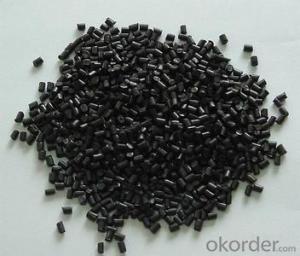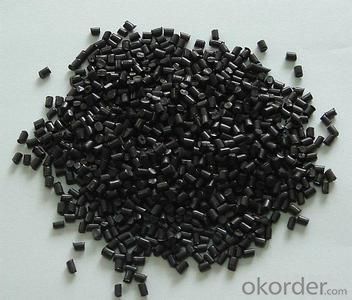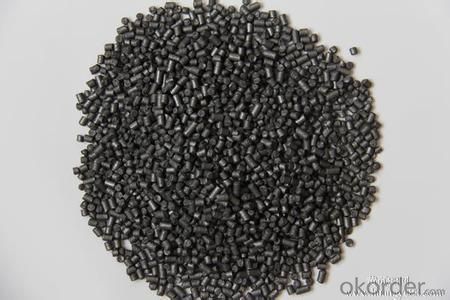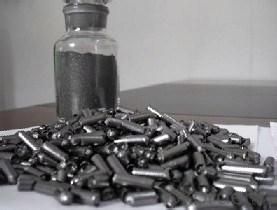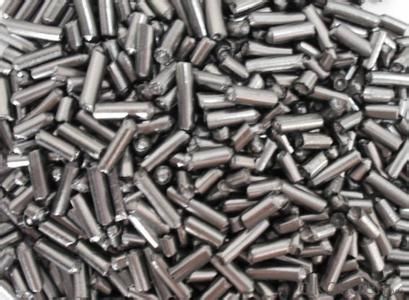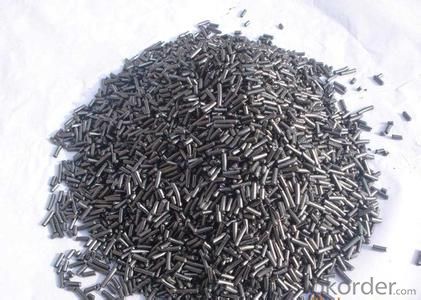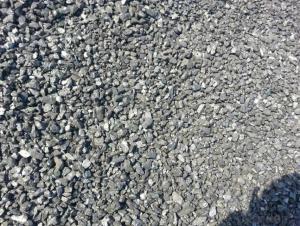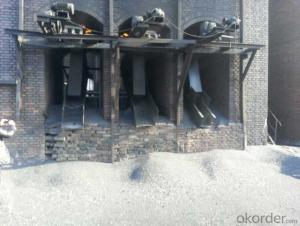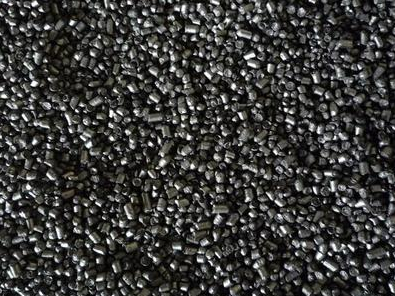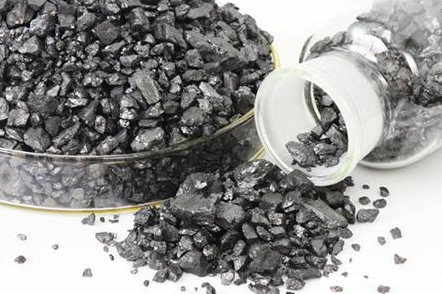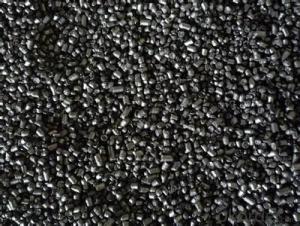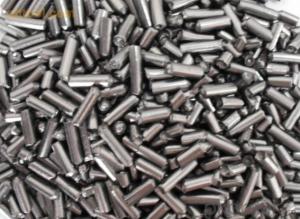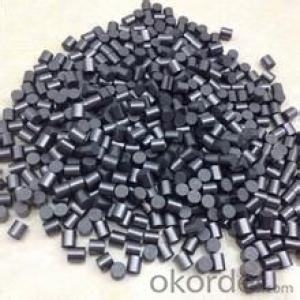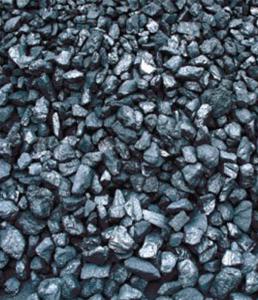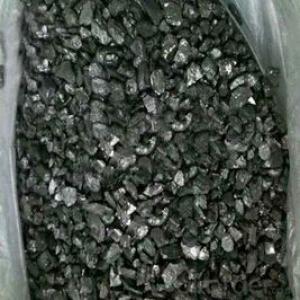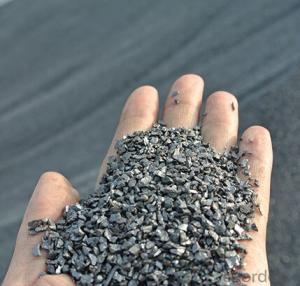carburant for casting iron and steel plant carbon additive and recarburizer
- Loading Port:
- Qingdao
- Payment Terms:
- TT OR LC
- Min Order Qty:
- 10 m.t
- Supply Capability:
- 300000 m.t/month
OKorder Service Pledge
OKorder Financial Service
You Might Also Like
Specifications of carburant:
- Carburant for casting professional manufacturer in china 15 years experience;
- Carburant for casting specification as follows:
Item No (max) | Fixed Carbon | Sulfur(max) | Ash(max) | V.M | Moisture | Grain size(90%) | Nitrogen(max) |
CA-02 | 98.50% | 0.50% | 0.80% | 0.80% | 0.50% | 1-5MM | N/A |
CA-06 | 99.00% | 0.30% | 0.50% | 0.50% | 0.50% | 1-5MM | 1000divdivM |
CA-10 | 95.00% | 0.30% | 3.50% | 1.50% | 0.50% | 1-4MM | 700divdivM |
CA-12 | 80.00% | 0.10% | 16.50% | 3.50% | 2.00% | 1-5mm | N/A |
By using the carbon additive from CNBM in producing casting, it can increase the used quantity of Scrap steel and reduce the quantity of Scrap iron, or use no Scrap iron at all, CNBM carbon additive has follows properties: high absorptive character, no residue will be left, save production cost.
- Usage used to improve the Carbon content in steel-melting and Ductile iron foundry
- Characteristica high carbon, low sulfur, with stable effect for improving the carbon content, high absorptivity of carbon.
- Apply Used in electric furnace steel smelting and cast-iron for improving the carbon content
- Grain size normal size0.3-3mm 1-4mm1-3mm3-5mm,3-8mm,5-10mm or per as customers special requirement.
- Q: How does carbon contribute to the strength of concrete?
- Carbon can contribute to the strength of concrete in several ways. One of the primary ways is through the use of carbon nanotubes (CNTs) or carbon fibers. These materials are added to the concrete mixture, acting as reinforcement and enhancing its mechanical properties. When CNTs or carbon fibers are incorporated into the concrete, they create a network of small, strong, and lightweight particles. This network helps to improve the overall strength and durability of the concrete, making it more resistant to cracking, flexing, and other forms of structural damage. Additionally, the carbon particles also enhance the bonding between the cement paste and the aggregates in the concrete. This improved bonding increases the interfacial strength, resulting in a stronger and more cohesive concrete matrix. Furthermore, carbon can also contribute to the strength of concrete by acting as a pozzolan. Pozzolans are materials that react chemically with calcium hydroxide, a byproduct of cement hydration, to form additional cementitious compounds. These compounds fill in the gaps between cement particles, resulting in a denser and stronger concrete structure. Carbon black, a type of finely divided carbon, is commonly used as a pozzolan in concrete mixes. Overall, the incorporation of carbon in concrete, whether through carbon nanotubes, carbon fibers, or as a pozzolan, can significantly enhance its strength and performance. By reinforcing the concrete matrix, improving bonding, and filling in gaps, carbon helps to create a more durable and robust material suitable for various construction applications.
- Q: What is the carbon content of different types of household waste?
- The carbon content of different types of household waste can vary depending on the specific materials being discarded. Generally, organic waste such as food scraps, yard waste, and paper products tend to have a higher carbon content compared to inorganic waste like glass, plastics, and metals. Food waste is primarily composed of organic materials and has a high carbon content. It typically ranges from 50 to 70 percent carbon content. This is because food is derived from plants and animals, which contain carbohydrates, proteins, and fats that are rich in carbon. Yard waste, such as grass clippings, leaves, and branches, also has a substantial carbon content. It contains plant matter that is predominantly made up of cellulose and lignin, which are carbon-based compounds. The carbon content of yard waste can vary depending on the type of vegetation, but it generally falls within the range of 40 to 60 percent. Paper products, such as newspapers, cardboard, and office paper, are primarily made from wood pulp. Wood is composed of cellulose, hemicellulose, and lignin, all of which contain carbon. As a result, paper waste has a significant carbon content, typically ranging from 40 to 60 percent. On the other hand, inorganic waste materials like glass, plastics, and metals have minimal carbon content. These materials are primarily derived from non-renewable resources such as minerals and fossil fuels, which are low in carbon content. Therefore, their carbon content is negligible or close to zero. It is important to note that while organic waste contains higher carbon content, it also has the potential to be composted or converted into biogas through anaerobic digestion, thereby contributing to carbon sequestration or renewable energy generation. In contrast, inorganic waste materials like plastics and metals are non-biodegradable and can have detrimental environmental impacts if not properly managed.
- Q: How does carbon contribute to global warming?
- Carbon contributes to global warming through the greenhouse effect. When carbon dioxide (CO2) and other greenhouse gases are released into the atmosphere through human activities like burning fossil fuels, deforestation, and industrial processes, they trap heat from the sun and prevent it from escaping back into space. This leads to an increase in the Earth's temperature, resulting in global warming and climate change.
- Q: What are the environmental impacts of burning fossil fuels?
- The burning of fossil fuels has significant environmental consequences that contribute to both climate change and air pollution. When coal, oil, and natural gas are burned, they release greenhouse gases, primarily carbon dioxide (CO2), into the atmosphere. These gases trap heat, resulting in global warming and climate change. The increased concentration of CO2 in the atmosphere is the main cause of global warming, which leads to higher temperatures and changes in weather patterns. Consequently, natural disasters like hurricanes, droughts, and floods become more frequent and severe. The melting of polar ice caps and glaciers is also accelerated, causing rising sea levels that pose a threat to coastal communities and ecosystems. In addition to climate change, the burning of fossil fuels releases other harmful air pollutants, including nitrogen oxides (NOx) and sulfur dioxide (SO2). These pollutants contribute to the formation of smog and acid rain, which have detrimental effects on human health, agriculture, and ecosystems. Furthermore, the extraction and transportation of fossil fuels cause environmental degradation. Activities such as coal mining and oil drilling can result in deforestation, destruction of habitats, and pollution of soil and water. Oil spills from offshore drilling operations, like the Deepwater Horizon disaster in the Gulf of Mexico, have devastating consequences for marine life and ecosystems. Overall, the environmental impacts of burning fossil fuels are extensive and severe. It is crucial to transition to cleaner and renewable energy sources in order to mitigate climate change, reduce air pollution, and protect our planet for future generations.
- Q: What are the impacts of carbon emissions on water scarcity?
- Carbon emissions have significant impacts on water scarcity as they contribute to climate change, which alters precipitation patterns and increases the frequency and intensity of droughts. Additionally, carbon emissions from industrial activities and fossil fuel combustion can lead to water pollution, further exacerbating water scarcity by degrading water quality and reducing available resources for human consumption and agriculture.
- Q: Is aluminum alloy expensive or high carbon steel expensive?
- Aluminum must be expensive, carbon steel is rubbish
- Q: How is carbon used in the production of textiles?
- Textile production utilizes carbon in multiple ways, encompassing the utilization of carbon fibers, activated carbon, carbon black, and carbon nanotubes. Carbon fibers, for instance, serve as a lightweight and sturdy reinforcement for fabrics, enhancing their durability and performance. Activated carbon, known for its porous nature, finds extensive use in the textile industry due to its ability to adsorb and eliminate undesirable odors and chemicals. Consequently, it is employed in the manufacturing of sportswear, workwear, and specialized textiles where odor control is crucial. Additionally, carbon black, a finely powdered substance composed of carbon particles, functions as a pigment in textile printing and dyeing. By imparting a deep black hue, it is widely employed in the production of garments, upholstery, and other textiles requiring a dark coloration. Moreover, the development of carbon nanotextiles represents an innovative application of carbon in the textile realm. These textiles, fabricated from carbon nanotubes, exhibit exceptional properties such as high electrical conductivity and thermal stability. Consequently, they are ideal for applications involving wearable electronics, smart textiles, and conductive fabrics. In conclusion, carbon's incorporation into textiles through the integration of carbon fibers, activated carbon, carbon black, and carbon nanotubes contributes significantly to the strength, durability, odor control, coloration, and functionality of various textile types.
- Q: How does carbon affect the formation of landslides?
- The formation of landslides is not directly influenced by carbon. Instead, natural factors such as heavy rainfall, earthquakes, or volcanic activity, as well as human activities like deforestation or construction, primarily trigger landslides. However, carbon does have an indirect role in landslides through its impact on the environment. The emission of excessive carbon dioxide (CO2) is primarily caused by human activities like burning fossil fuels and deforestation, and this contributes to climate change. As a result of climate change, rainfall events become more frequent and intense, increasing the likelihood of landslides. The increased rainfall saturates the soil, making it heavier and more susceptible to sliding, particularly on steep slopes. Deforestation is another way in which carbon indirectly affects landslides. Trees play a crucial role in stabilizing slopes by anchoring the soil with their root systems. However, when forests are cleared for agriculture, urbanization, or logging, the loss of tree cover weakens the soil's stability and raises the risk of landslides. Furthermore, the absence of vegetation reduces rainfall absorption, leading to increased surface runoff and erosion, further destabilizing slopes and making them more prone to landslides. In conclusion, while carbon itself does not directly cause landslides, its impact on climate change and deforestation can indirectly contribute to the occurrence and severity of landslides. Addressing carbon emissions and promoting sustainable land management practices are essential to mitigate the risk of landslides and preserve the stability of slopes.
- Q: Is badminton all good as carbon or aluminum carbon? Does carbon fiber on the Internet mean total carbon?
- Of course, it's all carbon. It's OK. Good elasticity, toughness and strength. It's better than aluminum. Now the regular professional racket is all carbon fiber and high elastic carbon fiber, you go to the store to see the hang of the racket, you will know
- Q: Which carbon content is larger, steel or pig iron?
- Iron and steel is distinguished by carbon: carbon content below 2.11% for carbon steel, according to can be divided into carbon steel low carbon steel (WC = 0.25%), carbon steel (WC0.25% - 0.6%) and high carbon steel (WC>0.6%);
Send your message to us
carburant for casting iron and steel plant carbon additive and recarburizer
- Loading Port:
- Qingdao
- Payment Terms:
- TT OR LC
- Min Order Qty:
- 10 m.t
- Supply Capability:
- 300000 m.t/month
OKorder Service Pledge
OKorder Financial Service
Similar products
Hot products
Hot Searches
